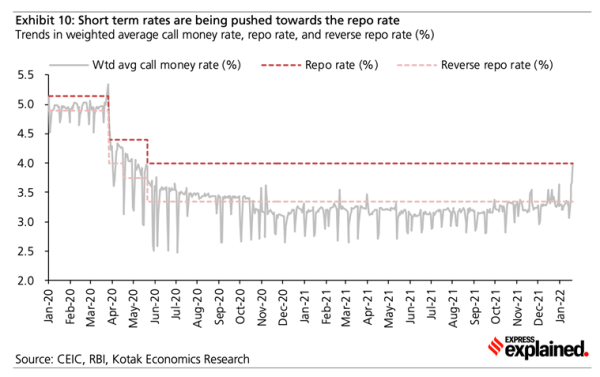Context
-
In a recent report, State Bank of India, which is the largest public sector bank in the country, has stated: “…we believe the stage is set for a reverse repo normalisation.”
What is monetary policy normalisation?
- India’s central bank, the Reserve Bank of India, keeps tweaking the total amount of money in the economy to ensure smooth functioning. As such, when the RBI wants to boost economic activity it adopts a so-called “loose monetary policy”.
- There are two parts to such a policy.
- One, the RBI injects more money (liquidity) into the economy. It does so by buying government bonds from the market. As the RBI buys these bonds, it pays back money to the bondholders, thus injecting more money into the economy.
- Two, the RBI also lowers the interest rate it charges banks when it lends money to them; this rate is called the repo rate.
- By lowering the interest rate at which it lends money to commercial banks, the RBI hopes that the commercial banks (and the rest of the banking system), in turn, will feel incentivised to lower interest rates. Lower interest rates and more liquidity, together, are expected to boost both consumption and production in the economy.
- For a consumer, it would now pay less to keep the money in the bank — thus it incentivises current consumption. For firms and entrepreneurs, it would make more sense to borrow money to start a new enterprise because interest rates are lower.
Tight Monetary policy
- The reverse of a loose monetary policy is a “tight monetary policy” and it involves the RBI raising interest rates and sucking liquidity out of the economy by selling bonds (and taking money out of the system).
- When any central bank finds that a loose monetary policy has started becoming counterproductive (for example, when it leads to a higher inflation rate), the central bank “normalises the policy” by tightening the monetary policy stance.
What is reverse repo and how does it fit into policy normalisation?
- The reverse repo is the interest rate that the RBI pays to the commercial banks when they park their excess “liquidity” (money) with the RBI. The reverse repo, thus, is the exact opposite of the repo rate.

Credit: IE - Under normal circumstances, that is when the economy is growing at a healthy pace, the repo rate becomes the benchmark interest rate in the economy. That’s because it is the lowest rate of interest at which funds can be borrowed. As such, the repo rate forms the floor interest rate for all other interest rates in the economy — be it the rate you pay for a car loan or a home loan or the interest you earn on your fixed deposit etc.
- But imagine a scenario where the RBI pumps more and more liquidity into the market but there are no takers of fresh loans — either because the banks are unwilling to lend or because there is no genuine demand for new loans in the economy. In such a scenario, the action shifts from repo rate to reverse repo rate because banks are no longer interested in borrowing money from the RBI. Rather they are more interested in parking their excess liquidity with the RBI. And that is how the reverse repo becomes the actual benchmark interest rate in the economy.
- As this story from early 2020 explained, the reverse repo had become the benchmark rate in India since the start of the Covid pandemic. In short, the RBI had widened the gap between repo rate and reverse repo rate (SEE CHART) in order to make it less attractive for banks to simply park their funds at the RBI. A lower reverse repo rate pushed banks to extend more fresh loans in the economy.
What does reverse repo normalisation mean?
- Simply put, it means the reverse repo rates will go up.
- Over the past few months, in the face of rising inflation, several central banks across the world have either increased interest rates or signaled that they would do so soon.
- In India, too, it is expected that the RBI will raise the repo rate. But before that, it is expected that the RBI will raise the reverse repo rate and reduce the gap between the two rates. In the immediate aftermath of Covid, RBI had increased this gap.
- Doing this will incentivise commercial banks to park excess funds with RBI, thus sucking some liquidity out of the system.
- The next step would be raising the repo rate.
Visit Abhiyan PEDIA (One of the Most Followed / Recommended) for UPSC Revisions: Click Here
IAS Abhiyan is now on Telegram: Click on the Below link to Join our Channels to stay Updated
IAS Abhiyan Official: Click Here to Join
For UPSC Mains Value Edition (Facts, Quotes, Best Practices, Case Studies): Click Here to Join
